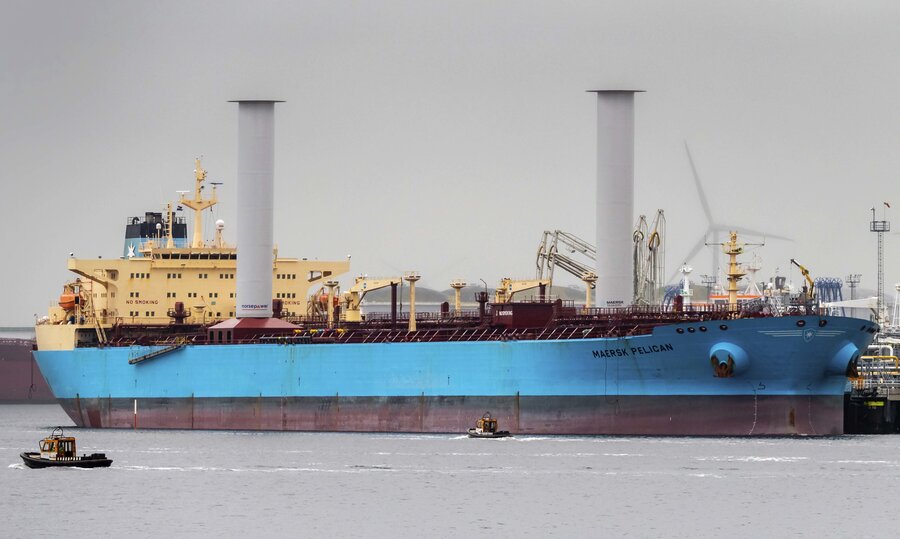Shipping companies unfurl greener solutions for transit
Loading...
| London
As the shipping industry faces pressure to cut climate-altering greenhouse gases, one answer is blowing in the wind.
European and United States tech companies, including one backed by airplane maker Airbus, are pitching futuristic sails to help cargo ships harness the free and endless supply of wind power. While they sometimes don't even look like sails – some are shaped like spinning columns – they represent a cheap and reliable way to reduce CO2 emissions for an industry that depends on a particularly dirty form of fossil fuels.
"It's an old technology," said Tuomas Riski, the CEO of Finland's Norsepower, which added its "rotor sail" technology for the first time to a tanker in August. "Our vision is that sails are coming back to the seas."
Denmark's Maersk Tankers is using its Maersk Pelican oil tanker to test Norsepower's 98-foot deck-mounted spinning columns, which convert wind into thrust based on an idea first floated nearly a century ago.
Separately, AP Moller-Maersk, which shares the same owner and is the world's biggest container shipping company, pledged this week to cut carbon emissions to zero by 2050, which will require developing commercially viable carbon neutral vessels by the end of next decade.
The shipping sector's interest in "sail tech" and other ideas took on greater urgency after the International Maritime Organization, the United Nations' maritime agency, reached an agreement in April to slash emissions by 50 percent by 2050.
Transport's contribution to earth-warming emissions are in focus as negotiators in Katowice, Poland, gather for United Nations talks to hash out the details of the 2015 Paris accord on curbing global warming.
Shipping, like aviation, isn't covered by the Paris agreement because of the difficulty attributing their emissions to individual nations, but environmental activists say industry efforts are needed. Ships belch out nearly 1 billion tons of carbon dioxide a year, accounting for 2-3 percent of global greenhouse gases. The emissions are projected to grow between 50 to 250 percent by 2050 if no action is taken.
Notoriously resistant to change, the shipping industry is facing up to the need to cut its use of cheap but dirty "bunker fuel" that powers the global fleet of 50,000 vessels – the backbone of world trade.
The IMO is taking aim more broadly at pollution, requiring ships to start using low-sulfur fuel in 2020 and sending ship owners scrambling to invest in smokestack scrubbers, which clean exhaust, or looking at cleaner but pricier distillate fuels.
A Dutch group, the Goodshipping Program, is trying biofuel, which is made from organic matter. It refueled a container vessel in September with 22,000 liters of used cooking oil, cutting carbon dioxide emissions by 40 tons.
In Norway, efforts to electrify maritime vessels are gathering pace, highlighted by the launch of the world's first all-electric passenger ferry, Future of the Fjords, in April. Chemical maker Yara is meanwhile planning to build a battery-powered autonomous container ship to ferry fertilizer between plant and port.
Ship owners have to move with the times, said Bjørn Tore Orvik, Yara's project leader.
Building a conventional fossil-fueled vessel "is a bigger risk than actually looking to new technologies ... because if new legislation suddenly appears then your ship is out of date," said Mr. Orvik.
Batteries are effective for coastal shipping, though not for long-distance sea voyages, so the industry will need to consider other "energy carriers" generated from renewable power, such as hydrogen or ammonia, said Jan Kjetil Paulsen, an advisor at the Bellona Foundation, an environmental non-government organization. Wind power is also feasible, especially if vessels sail more slowly.
"That is where the big challenge lies today," said Mr. Paulsen.
Wind power looks to hold the most promise. The technology behind Norsepower's rotor sails, also known as Flettner rotors, is based on the principle that airflow speeds up on one side of a spinning object and slows on the other. That creates a force that can be harnessed.
Rotor sails can generate thrust even from wind coming from the side of a ship. German engineer Anton Flettner pioneered the idea in the 1920s but the concept languished because it couldn't compete with cheap oil.
On a windy day, Norsepower says rotors can replace up to 50 percent of a ship's engine propulsion. Overall, the company says it can cut fuel consumption by 7 to 10 percent.
Maersk Tankers said the rotor sails have helped the Pelican use less engine power or go faster on its travels, resulting in better fuel efficiency, though it didn't give specific figures.
One big problem with rotors is they get in the way of port cranes that load and unload cargo. To get around that, US startup Magnuss has developed a retractable version. The New York-based company is raising $10 million to build its concept, which involves two 50-foot steel cylinders that retract below deck.
"It's just a better mousetrap," said CEO James Rhodes, who says his target market is the "Panamax" size bulk cargo ships carrying iron ore, coal, or grain.
High tech versions of conventional sails are also on the drawing board.
Spain's bound4blue is creating an aircraft wing-like sail that collapses like an accordion, according to a video of a scaled-down version from a recent trade fair. The first two will be installed next year followed by five more in 2020.
The company is in talks with 15 more ship owners from across Europe, Japan, China, and the US to install its technology, said co-founder Cristina Aleixendrei.
Ship owners are now "more desperate for new technology to reduce fuel consumption," she said
Airseas, backed by European plane maker Airbus, plans to deploy its parachute-like automated kite sails on ships ferrying fuselages from France to Alabama starting in 2020. The company predicts that the "Seawing" will reduce fuel use by 20 percent on the 13-day journey.
This story was reported by The Associated Press. David Keyton in Oslo contributed to this report.







